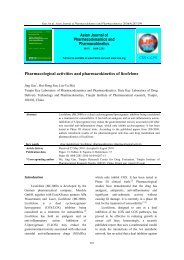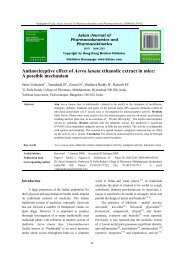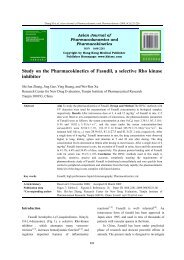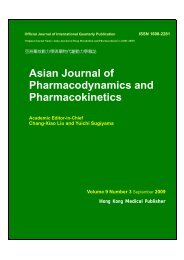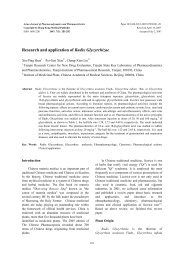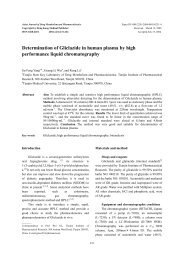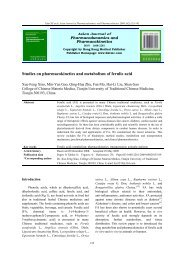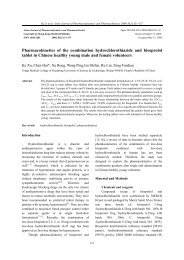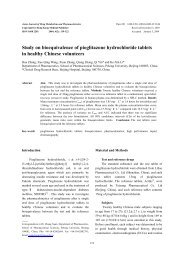Asian Journal of Pharmacodynamics and Pharmacokinetics
Asian Journal of Pharmacodynamics and Pharmacokinetics
Asian Journal of Pharmacodynamics and Pharmacokinetics
Create successful ePaper yourself
Turn your PDF publications into a flip-book with our unique Google optimized e-Paper software.
Xu HY et al. <strong>Asian</strong> <strong>Journal</strong> <strong>of</strong> <strong>Pharmacodynamics</strong> <strong>and</strong> <strong>Pharmacokinetics</strong> 2009; 9(1):11-25<br />
difference between the main pharmacokinetic<br />
parameters <strong>of</strong> the two enantiomers. THP showed<br />
significant stereoselective pharmaco- kinetics in rats<br />
after an ig dose <strong>of</strong> the racemate. [50]<br />
selective chiral HPLC method coupled with<br />
achiral column was developed <strong>and</strong> validated to<br />
separate <strong>and</strong> quantify THP enantiomers in dog<br />
plasma. Chromatography was accomplished by two<br />
steps: (1) racemic THP was separated from biological<br />
matrix <strong>and</strong> collected on a Kromasil C18 column (150<br />
mmx4.6 mm, 5µm) with the mobile phase<br />
acetonitrile-0.1% phosphoric acid solution, adjusted<br />
with triethylamine to pH 6.15 (47:53); (2)<br />
enantiomeric separation was performed on a<br />
Chiralcel OJ-H column (250 mmx4.6 mm, 5µm) with<br />
the mobile phase anhydrous ethanol. The detection<br />
wavelength was set at 230 nm. (+)-THP <strong>and</strong> (-)-THP<br />
were separated with a resolution factor (Rs) <strong>of</strong> at<br />
least 1.6 <strong>and</strong> a separation factor (alpha) greater than<br />
1.29. Linear calibration curves were obtained over<br />
the range <strong>of</strong> 0.025-4 µg·mL -1 in plasma for each <strong>of</strong><br />
(+)-THP <strong>and</strong> (-)-THP (R 2 >0.999) with a limit <strong>of</strong><br />
detection (LOD) <strong>of</strong> 0.005 µg·mL -1 <strong>and</strong> the recovery<br />
was greater than 88% for each enantiomer. The<br />
method was used to determine the pharmacokinetics<br />
<strong>of</strong> THP enantiomers after oral administration <strong>of</strong><br />
racemic THP. The results presented herein showed<br />
the stereoselective disposition kinetics <strong>of</strong> THP in<br />
dogs <strong>and</strong> were a further contribution to the<br />
underst<strong>and</strong>ing <strong>of</strong> the kinetic behavior <strong>of</strong> THP<br />
analogues. [51]<br />
The main objective <strong>of</strong> this study was to<br />
determine the brain pharmacokinetics <strong>and</strong> tissue<br />
distribution <strong>of</strong> THP enantiomers in rats after oral<br />
administration <strong>of</strong> racemic THP (rac-THP). Rats (5<br />
animals/group/per time) were given a single oral dose<br />
<strong>of</strong> rac-THP <strong>and</strong> killed after different post-treatment<br />
times. The concentrations <strong>of</strong> THP enantiomers in<br />
plasma, cortex, cerebellum, diencephalon, brain stem,<br />
striatum <strong>and</strong> hippocampus were measured using a<br />
validated chiral HPLC method coupled with an<br />
achiral column. The pharmacokinetic pr<strong>of</strong>iles <strong>of</strong> the<br />
two enantiomers in six brain regions were<br />
significantly different. The peak concentrations (C max )<br />
<strong>and</strong> AUC 0-infinity values <strong>of</strong> the (-)-enantiomer were<br />
significantly greater than the corresponding values<br />
for the (+)-enantiomer while the striatum contained<br />
the highest peak concentrations compared with the<br />
plasma <strong>and</strong> other brain regions. The tissue<br />
distribution studies also revealed significant<br />
differences between the two enantiomers in all tissues<br />
except the lung. The highest concentrations <strong>of</strong> both<br />
enantiomers were found in the liver. The (-)/(+)-THP<br />
ratios in six brain regions <strong>and</strong> other tissues were<br />
consistent with that observed in plasma indicating<br />
that the stereoselective disposition <strong>of</strong> THP in rat brain<br />
<strong>and</strong> other tissues reflects the situation in plasma. [52]<br />
THP is the active component in Rhizoma<br />
corydalis <strong>and</strong> the medicine Yuanhu-Baizhi (YB),<br />
which consists <strong>of</strong> Rhizoma corydalis <strong>and</strong> Radix<br />
angelicae dahuricae. The aim <strong>of</strong> this work was to<br />
compare pharmacokinetic features <strong>of</strong> THP<br />
enantiomers in rats dosed with racemic THP<br />
(rac-THP), Rhizoma corydalis, or YB extracts. A<br />
single dose <strong>of</strong> rac-THP (5 mg·kg -1 ) or extracts <strong>of</strong><br />
Rhizoma corydalis <strong>and</strong> YB (both equivalent to 5<br />
mg·kg -1 <strong>of</strong> rac-THP) was given orally to three groups<br />
<strong>of</strong> Sprague-Dawley rats, respectively. Blood samples<br />
were collected periodically <strong>and</strong> plasma<br />
concentrations <strong>of</strong> THP enantiomers were determined<br />
using an achiral-chiral HPLC method previously<br />
reported, with some modifications. The C max ratio<br />
(-/+) <strong>of</strong> THP was 2.91, 1.38, <strong>and</strong> 1.19, <strong>and</strong> the AUC 0<br />
approximately infinity) ratio (-/+) <strong>of</strong> THP was 2.84, 1.50, <strong>and</strong><br />
1.35 in rats after dosed with rac-THP, extracts <strong>of</strong><br />
Rhizoma corydalis <strong>and</strong> YB, respectively. The mean<br />
AUC 0 approximately infinity <strong>and</strong> C max <strong>of</strong> (+)-THP dosed with<br />
YB extracts were 0.652 ± 0.30 µg·h·ml -1 <strong>and</strong> 0.148<br />
±0.09 µg·ml -1 , significantly higher (P < 0.05) than<br />
those dosed with rac-THP <strong>and</strong> Rhizoma corydalis<br />
extracts. The mean AUC 0 approximately infinity <strong>and</strong> T max <strong>of</strong><br />
rac-THP dosed with YB extracts were 1.500 ± 0.56<br />
µg·h·ml -1 <strong>and</strong> 2.12 ±1.1 h, significantly higher (P <<br />
0.05) than those dosed with rac-THP or Rhizoma<br />
corydalis extracts. These findings suggested the<br />
stereoselectivity in pharmacokinetics <strong>of</strong> THP<br />
enantiomers in rats was decreased when dosed in<br />
plant form, while the AUC 0-approximately infinity <strong>of</strong><br />
rac-THP increased when YB extracts were dosed,<br />
confirming the compatibility in drug combination <strong>of</strong><br />
Rhizoma corydalis <strong>and</strong> Radix angelicae dahuricae. [53]<br />
The main objective <strong>of</strong> this study was to<br />
determine the brain pharmacokinetics <strong>and</strong> tissue<br />
distribution <strong>of</strong> THP enantiomers in rats after oral<br />
administration <strong>of</strong> racemic THP (rac-THP). Rats (5<br />
animals/group/per time) were given a single oral dose<br />
21



